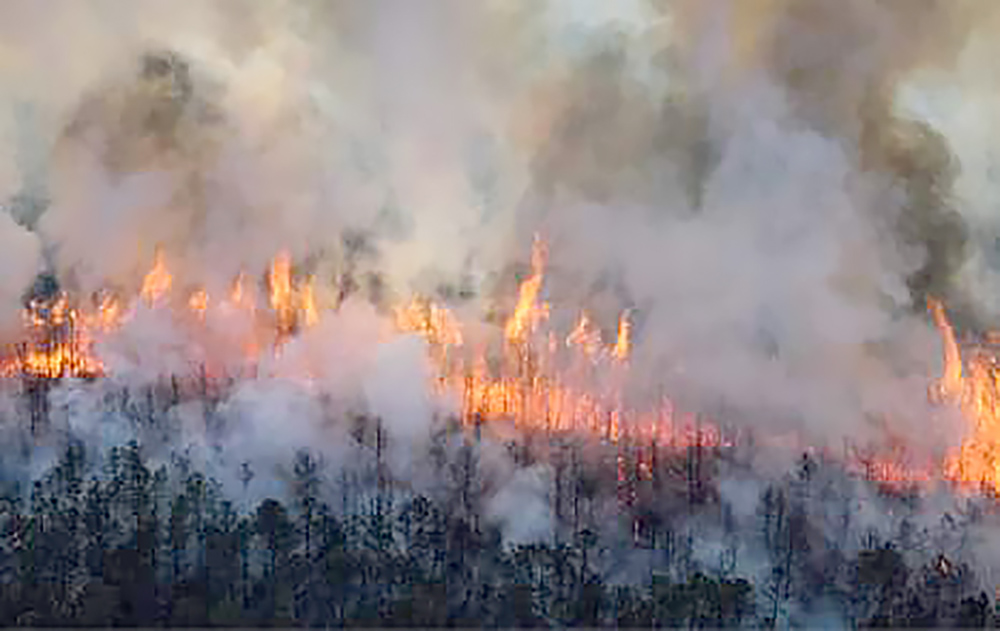Weather
By Dan Skeldon
Replace hazy, hot, and humid, three alliterative weather words that usually become quite common starting in June, with hazy, dry, and smoky. Sure, you lose the alliteration. But the latter is definitely more applicable here in South Jersey of late, from our drought last fall to renewed dryness and a protracted and active wildfire season this April, May, and June.
Instead of delivering heat and humidity, the first weekend of June brought two late-in-the-season wildfires, one in the Bass River State Forest that burned over 5,000 acres and also necessitated the closure of roads, including the Garden State Parkway. Ash accumulated on some cars and patio furniture, and the sight and smell of smoke lay heavy in the late spring air. Another fire in Burlington County near Medford, while only a few hundred acres, did threaten some homes before being contained.
And then there was a nearly 4,000 acre wildfire in Ocean County back in April that made national headlines as well. For every fire, firefighters fought heroically over days to knock down the flames and extinguish the blaze. And from South Jersey to Southern Canada, they always fight the good fight, and it’s truly amazing what they accomplish.
All of these fires are in part fueled by the dry conditions, brisk winds, and low relative humidity that have all been present in combination more so than usual. And if extended windy and dry stretches become more common as a result of our changing climate, more intense fire seasons could result. It’s true that a warming climate is in theory a wetter one, with floods more likely than drought in our small corner of the world. But an occasional dry spell or drought, perhaps more pronounced or extended than normal, could in theory lead to worse fire seasons ahead.
Of course, brush and forest fires are a natural annual occurrence in the Pinelands, over one million acres of natural, largely undeveloped land, the largest such tract of land in the otherwise heavily developed Northeast Corridor from Washington to Boston. And not only are they expansive, but explosive as well. The pitch pines and shrubby oaks that make up much of the Pinelands, anchored in acidic and sandy soil, contain a high amount of potentially explosive fuel that any fire can utilize to burn hot and spread rapidly.
Perhaps one of the more notable examples was in the spring of 1963, one of the driest on record. Multiple April fires throughout the Pinelands burned over 180,000 acres, destroyed almost 400 structures, and took seven lives. Of course, there is much more development in specified corridors of the Pinelands now, and similar conditions today would prove much more destructive.
Controlled burns and forest management are a good way to play defense, as is extreme caution with outdoor flames any time of the year, no matter how dry or wet the weather pattern is. And the more defensible space around your home, anywhere from 30 to preferably as much as 100 or more feet of largely open and forest-free space near your home, is a particularly important preventive measure that Pinelands homeowners can undertake. But as beautiful and as much of a treasure the Pinelands are to South Jersey, the fire danger contained within should always be respected.
Now it’s not just South Jersey that is having a smoky spring this year. Our neighbor to the north, Canada, is having one of their worst starts to wildfire season on record. Large forest fires in Alberta in western Canada have been sending a constant plume of smoke and haze that has shrouded much of the Great Lakes and Northeast throughout May and June. And it’s not only the prairie provinces of western Canada, but the maritime provinces in the east, like Nova Scotia for instance, that have seen a fast and furious fire season this spring, sending smoke and haze west across the Atlantic in our direction. And most recently, smoke from fires in Quebec are riding brisk northerly winds down Route 9 from Upstate New York and right into South Jersey. This is mostly high altitude haze, usually seen but not smelt near the ground. But if the smoke is thick enough and the atmosphere mixed enough, there can be a smoky smell near the ground and air quality issues for the most sensitive too.
And let’s not forget the traditionally active Western United States as well. Due in part to current weather patterns, not to mention some record rain and snow this winter and early spring, things are comparatively quiet from the Rockies on west at last check. That serves as a nice reminder that our changing climate doesn’t mean that everyone is going to burn, or flood, or be blown away by a hurricane. However, forest fire season across North America has turned more intense in the past few decades, and hazy skies from distant fires, or ash and a smoky smell from nearby fires, are a more common occurrence now than in year’s past, or so it seems. In my evening television weathercasts this spring, I’ve been frequently using our smoke tracker to track where plumes of high altitude smoke are forecast to travel in the coming days. Meanwhile, our future satellite/radar product has had little rain to track, with little in sight, at least through the first 10 days of the month, perhaps longer.
So time will tell if those lazy, hazy, crazy days of summer will need to have smoky worked in this year or in years to come.
Meteorologist Dan Skeldon has a degree in meteorology from Cornell University. He has forecasted the weather in South Jersey for the last 18 years, first on the former television station NBC40 and then on Longport Media radio. Dan has earned the American Meteorological Society Seal of Approval for Broadcast Meteorologists, and now does television broadcasts on WFMZ-TV in Pennsylvania’s Lehigh Valley.










